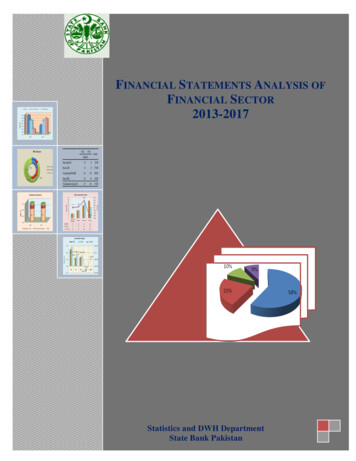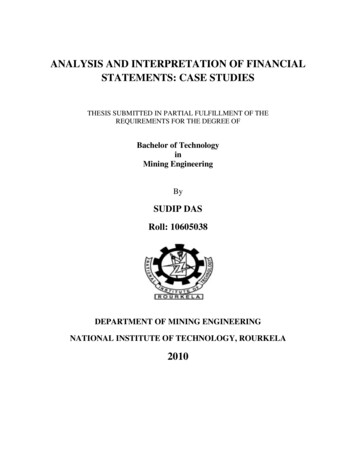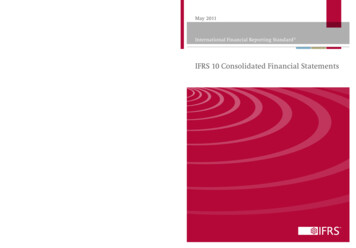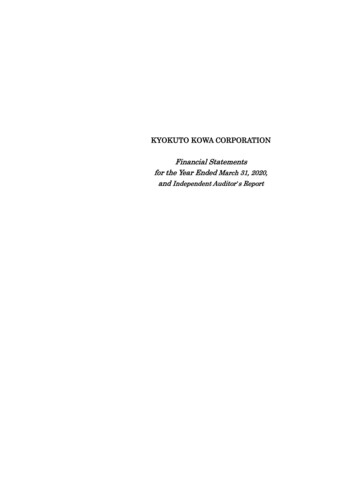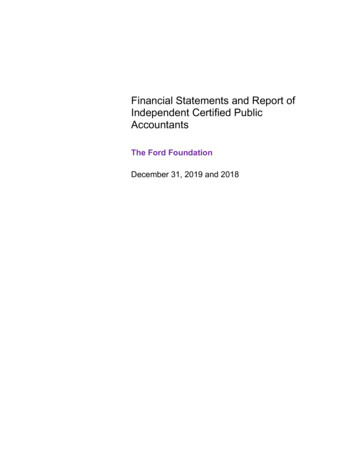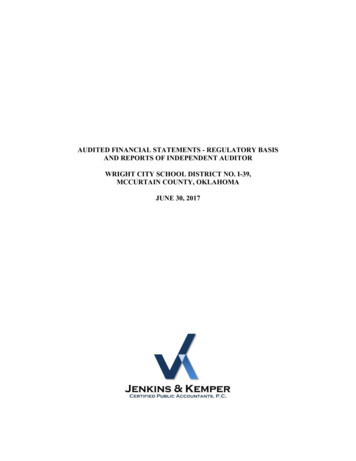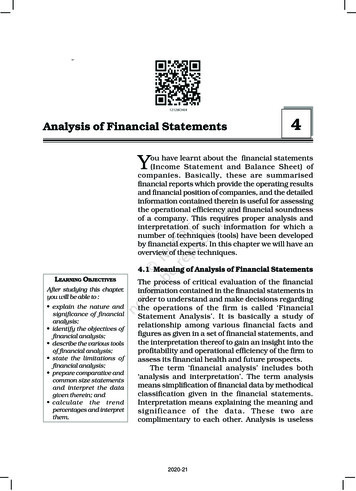
Transcription
Analysis of Financial Statements169Analysis of Financial Statements4You have learnt about the financial statements(Income Statement and Balance Sheet) ofcompanies. Basically, these are summarisedfinancial reports which provide the operating resultsand financial position of companies, and the detailedinformation contained therein is useful for assessingthe operational efficiency and financial soundnessof a company. This requires proper analysis andinterpretation of such information for which anumber of techniques (tools) have been developedby financial experts. In this chapter we will have anoverview of these techniques.4.1 Meaning of Analysis of Financial StatementsLEARNING OBJECTIVESAfter studying this chapter,you will be able to : explain the nature andsignificance of financialanalysis; identify the objectives offinancial analysis; describe the various toolsof financial analysis; state the limitations offinancial analysis; prepare comparative andcommon size statementsand interpret the datagiven therein; and calculate the trendpercentages and interpretthem.The process of critical evaluation of the financialinformation contained in the financial statements inorder to understand and make decisions regardingthe operations of the firm is called ‘FinancialStatement Analysis’. It is basically a study ofrelationship among various financial facts andfigures as given in a set of financial statements, andthe interpretation thereof to gain an insight into theprofitability and operational efficiency of the firm toassess its financial health and future prospects.The term ‘financial analysis’ includes both‘analysis and interpretation’. The term analysismeans simplification of financial data by methodicalclassification given in the financial statements.Interpretation means explaining the meaning andsignificance of the data. These two arecomplimentary to each other. Analysis is useless2020-21
170Accountancy : Company Accounts and Analysis of Financial Statementswithout interpretation, and interpretation without analysis is difficult or evenimpossible.Financial statement analysis is a judgemental process which aims to estimatecurrent and past financial positions and the results of the operation of anenterprise, with primary objective of determining the best possible estimatesand predictions about the future conditions. It essentially involves regroupingand analysis of information provided by financial statements to establishrelationships and throw light on the points of strengths and weaknesses of abusiness enterprise, which can be useful in decision-making involving comparisonwith other firms (cross sectional analysis) and with firms’ own performance,over a time period (time series analysis).4.2Significance of Analysis of Financial StatementsFinancial analysis is the process of identifying the financial strengths andweaknesses of the firm by properly establishing relationships between the variousitems of the balance sheet and the statement of profit and loss. Financial analysiscan be undertaken by management of the firm, or by parties outside the firm,viz., owners, trade creditors, lenders, investors, labour unions, analysts andothers. The nature of analysis will differ depending on the purpose of the analyst.A technique frequently used by an analyst need not necessarily serve the purposeof other analysts because of the difference in the interests of the analysts.Financial analysis is useful and significant to different users in the followingways:(a) Finance manager: Financial analysis focusses on the facts andrelationships related to managerial performance, corporate efficiency,financial strengths and weaknesses and creditworthiness of the company.A finance manager must be well-equipped with the different tools ofanalysis to make rational decisions for the firm. The tools for analysishelp in studying accounting data so as to determine the continuity of theoperating policies, investment value of the business, credit ratings andtesting the efficiency of operations. The techniques are equally importantin the area of financial control, enabling the finance manager to makeconstant reviews of the actual financial operations of the firm to analysethe causes of major deviations, which may help in corrective actionwherever indicated.(b) Top management: The importance of financial analysis is not limited tothe finance manager alone. It has a broad scope which includes topmanagement in general and other functional managers. Management ofthe firm would be interested in every aspect of the financial analysis. It istheir overall responsibility to see that the resources of the firm are2020-21
Analysis of Financial Statements(c)(d)(e)(f)(g)4.3171used most efficiently and that the firm’s financial condition is sound.Financial analysis helps the management in measuring the success ofthe company’s operations, appraising the individual’s performance andevaluating the system of internal control.Trade payables: Trade payables, through an analysis of financialstatements, appraises not only the ability of the company to meet itsshort-term obligations, but also judges the probability of its continuedability to meet all its financial obligations in future. Trade payables areparticularly interested in the firm’s ability to meet their claims over avery short period of time. Their analysis will, therefore, evaluate the firm’sliquidity position.Lenders: Suppliers of long-term debt are concerned with the firm’s longterm solvency and survival. They analyse the firm’s profitability over aperiod of time, its ability to generate cash, to be able to pay interest andrepay the principal and the relationship between various sources of funds(capital structure relationships). Long-term lenders analyse the historicalfinancial statements to assess its future solvency and profitability.Investors: Investors, who have invested their money in the firm’s shares,are interested about the firm’s earnings. As such, they concentrate onthe analysis of the firm’s present and future profitability. They are alsointerested in the firm’s capital structure to ascertain its influences onfirm’s earning and risk. They also evaluate the efficiency of themanagement and determine whether a change is needed or not. However,in some large companies, the shareholders’ interest is limited to decidewhether to buy, sell or hold the shares.Labour unions: Labour unions analyse the financial statements to assesswhether it can presently afford a wage increase and whether it can absorba wage increase through increased productivity or by raising the prices.Others: The economists, researchers, etc., analyse the financial statementsto study the present business and economic conditions. The governmentagencies need it for price regulations, taxation and other similar purposes.Objectives of Analysis of Financial StatementsAnalysis of financial statements reveals important facts concerningmanagerial performance and the efficiency of the firm. Broadly speaking,the objectives of the analysis are to apprehend the information containedin financial statements with a view to know the weaknesses and strengthsof the firm and to make a forecast about the future prospects of the firmthereby, enabling the analysts to take decisions regarding the operation of,2020-21
172Accountancy : Company Accounts and Analysis of Financial Statementsand further investment in the firm. To be more specific, the analysis isundertaken to serve the following purposes (objectives): to assess the current profitability and operational efficiency of thefirm as a whole as well as its different departments so as to judgethe financial health of the firm. to ascertain the relative importance of different components of thefinancial position of the firm. to identify the reasons for change in the profitability/financial positionof the firm. to judge the ability of the firm to repay its debt and assessing theshort-term as well as the long-term liquidity position of the firm.Through the analysis of financial statements of various firms, an economist canjudge the extent of concentration of economic power and pitfalls in the financialpolicies pursued. The analysis also provides the basis for many governmentalactions relating to licensing, controls, fixing of prices, ceiling on profits, dividendfreeze, tax subsidy and other concessions to the corporate sector.4.4Tools of Analysis of Financial StatementsThe most commonly used techniques of financial analysis are as follows:1.Comparative Statements: These are the statements showing theprofitability and financial position of a firm for different periods of time ina comparative form to give an idea about the position of two or more periods.It usually applies to the two important financial statements, namely,balance sheet and statement of profit and loss prepared in a comparativeform. The financial data will be comparative only when same accountingprinciples are used in preparing these statements. If this is not the case,the deviation in the use of accounting principles should be mentioned asa footnote. Comparative figures indicate the trend and direction of financialposition and operating results. This analysis is also known as ‘horizontalanalysis’.2.Common Size Statements: These are the statements which indicate therelationship of different items of a financial statement with a common itemby expressing each item as a percentage of that common item. Thepercentage thus calculated can be easily compared with the results ofcorresponding percentages of the previous year or of some other firms, asthe numbers are brought to common base. Such statements also allow ananalyst to compare the operating and financing characteristics of twocompanies of different sizes in the same industry. Thus, common sizestatements are useful, both, in intra-firm comparisons over different yearsand also in making inter-firm comparisons for the same year or for severalyears. This analysis is also known as ‘Vertical analysis’.2020-21
Analysis of Financial Statements1733.Trend Analysis: It is a technique of studying the operational results andfinancial position over a series of years. Using the previous years’ data of abusiness enterprise, trend analysis can be done to observe the percentagechanges over time in the selected data. The trend percentage is thepercentage relationship, in which each item of different years bear to thesame item in the base year. Trend analysis is important because, with itslong run view, it may point to basic changes in the nature of the business.By looking at a trend in a particular ratio, one may find whether the ratiois falling, rising or remaining relatively constant. From this observation, aproblem is detected or the sign of good or poor management is detected.4.Ratio Analysis: It describes the significant relationship which existsbetween various items of a balance sheet and a statement of profit andloss of a firm. As a technique of financial analysis, accounting ratios measurethe comparative significance of the individual items of the income andposition statements. It is possible to assess the profitability, solvency andefficiency of an enterprise through the technique of ratio analysis.5.Cash Flow Analysis: It refers to the analysis of actual movement of cashinto and out of an organisation. The flow of cash into the business is calledas cash inflow or positive cash flow and the flow of cash out of the firm iscalled as cash outflow or a negative cash flow. The difference between theinflow and outflow of cash is the net cash flow. Cash flow statement isprepared to project the manner in which the cash has been received andhas been utilised during an accounting year as it shows the sources ofcash receipts and also the purposes for which payments are made. Thus,it summarises the causes for the changes in cash position of a businessenterprise between dates of two balance sheets.In this chapter, we shall have a brief idea about the first three techniques,viz., comparative statements, common size statements and trend analysis. Theratio analysis and cash flow analysis is covered in detail in Chapters 5 and 6respectively.Test your Understanding – IFill in1.2.3.4.5.the blanks with appropriate word(s):Analysis simply means—————data.Interpretation means —————data.Comparative analysis is also known as ———————— analysis.Common size analysis is also known as ———————— analysis.The analysis of actual movement of money inflow and outflow in anorganisation is called——————— analysis.2020-21
1744.5Accountancy : Company Accounts and Analysis of Financial StatementsComparative StatementsAs stated earlier, these statements refer to the statement of profit and loss andthe balance sheet prepared by providing columns for the figures for both thecurrent year as well as for the previous year and for the changes during theyear, both in absolute and relative terms. As a result, it is possible to find outnot only the balances of accounts as on different dates and summaries ofdifferent operational activities of different periods, but also the extent of theirincrease or decrease between these dates. The figures in the comparativestatements can be used for identifying the direction of changes and also thetrends in different indicators of performance of an organisation.The following steps may be followed to prepare the comparative statements:Step 1 : List out absolute figures in rupees relating to two points of time (asshown in columns 2 and 3 of Exhibit 4.1).Step 2 : Find out change in absolute figures by subtracting the first year(Col.2) from the second year (Col.3) and indicate the change as increase ( ) ordecrease (–) and put it in column 4.Step 3 : Preferably, also calculate the percentage change as follows and put itin column 5.Absolute Increase or Decrease (Col.4) 100First year absolute figure (Col.2)Particulars1First YearSecond YearAbsoluteIncrease ( ) orDecrease (–)PercentageIncrease ( )or Decrease (–)2345Rs.Rs.Rs.%
position and operating results. This analysis is also known as ‘horizontal analysis’. 2. Common Size Statements: These are the statements which indicate the relationship of different items of a financial statement with a common item by expressing each item as a percentage of that common item. The
